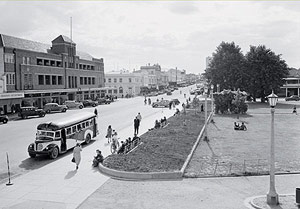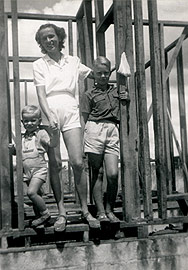A country town:
a place called home
a place called home

click to enlarge »
When the first postwar migrants arrived in Orange in 1948 it was a small country centre of 14,000 people surrounded by orchards and farms and populated mainly by people of British or Irish extraction.
Photo courtesy Australian National Archives, NAA:M914/1, 817477
When the first post World War ll migrants arrived in Orange they found themselves in a small country centre of nearly 14,000 people which had been declared a city only two years previously. In the year before the start of large-scale migration, the overwhelming majority of residents were of British or Irish extraction and stated their nationality as British, as was the custom then. There were just seven Chinese people and 13 Greeks, most of whom were men.

Ludmilla Kiho and her children Ivar and Alar at the house Ludmilla and her husband Leon built in Peisley Street.
Photo courtesy Leon and Ludmilla Kiho
click to enlarge »
Migrants settling in Orange in the postwar years faced a serious housing shortage. At first, many men working in Orange, at the Emmco factory and on the railways in particular, slept in tents or in boarding houses. A Commonwealth Hostel located next to the Emmco factory was opened in 1952 and for a number of years provided a temporary home for hundreds of British and European migrants.
As migrants started saving money, they bought blocks of land on the outskirts of Orange and started building homes. Firstly they would build a garage or temporary home and move into it until they could afford to build a proper house. Often several families would share a house for a while in order to save money.

